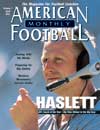Article CategoriesAFM Magazine
|
The Linebacker ShuffleGetting those big boys to move well is key to winning gamesby: Mark Harriman Head coach, Bates College © More from this issue We, as coaches, spend countless hours trying to develop the ideal offensive or defensive scheme. As impotant as these schemes are they cannot be practiced at the expense of developing fundamentals. As we all have witnessed, in crunch time it is the execution of fundamentals that often determines the outcome of a game. This is exemplified at the linebacker position in many ways but none more than stance and movement. A coach can drill key reaction and devise schemes to get a linebacker to the ball all day long, but if the player cannot put himself in position to get his body on the ball carrier the scheme work is fruitless. Like all positions in football, proper stance and movement out of this stance, are the foundation for great linebacker play.
|
|
|||||||
| HOME |
MAGAZINE |
SUBSCRIBE | ONLINE COLUMNISTS | COACHING VIDEOS |
Copyright 2025, AmericanFootballMonthly.com
All Rights Reserved





